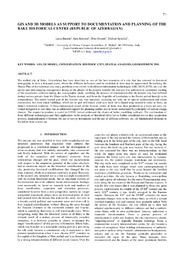| dc.contributor.author | Baratin, Laura | en |
| dc.contributor.author | Bertozzi, Sara | en |
| dc.contributor.author | Moretti, Elvio | en |
| dc.contributor.author | Spinella, Michele | en |
| dc.date.accessioned | 2013-02-13T09:30:54Z | en |
| dc.date.available | 2013-02-13T09:30:54Z | en |
| dc.date.issued | 2012-10-29 | en |
| dc.identifier.issn | 2047-4970 (Print) | en |
| dc.identifier.uri | http://hdl.handle.net/10797/6073 | en |
| dc.description.abstract | The walled city of Baku, Icherisheher has been described as one of the best examples of a city that has retained its historical stratigraphy in over a thousand years, where the different influences and its evolution in time may be appreciated. In realising the Master Plan of the historical city, many problems were solved with different information technologies (GIS, DEM, DTM, etc.) for the survey and data mapping management during all the phases of the project. Initially the analysis was addressed to systematic reading of the documents collected during the iconographic study, verifying the process of deterioration that the historic city had suffered during various periods from the Khans to the Tsarist domain, and from the Republic of Azerbaijan to the Soviet period through to its independence. The entire central part of the historic city was analyzed, including not only on its special architectural and urban monuments, but even minor buildings, which are in part still intact, used as a basis for a digital map created in order to focus on Baku's historical evolution. A three-dimensional model of the historic centre of Baku was then produced as a basis not only for virtual navigation in real time, but as additional support for planning studies and to better understand the principles of various design choices. The request to produce a model in VRML format addressed the choice of better modelling methods. The combination of these different technologies and their application in the analysis of historical cities led to further considerations on data acquisition systems, standardization of formats, the use of survey instruments and the use of different software, etc., all fundamental elements to the define their correct use. | en |
| dc.description.sponsorship | DiSBEF, University of Urbino, Campus Scientifico "E. Mattei", 60129 Urbino, Italy, GESP s. r. l., Italy. | en |
| dc.language.iso | eng | en |
| dc.publisher | Multi Science Publishing | en |
| dc.relation.ispartof | International Journal of Heritage in the Digital Era, Volume 1, Supplement 1, Pages 71-76 | en |
| dc.rights | info:eu-repo/semantics/openAccess | en |
| dc.subject | GIS | en |
| dc.subject | 3D MODEL | en |
| dc.subject | CONSERVATION | en |
| dc.subject | HISTORIC CITY | en |
| dc.subject | SPATIAL ANALYSIS | en |
| dc.subject | GEOREFERENCING | en |
| dc.title | GIS and 3D Models as Support to Documentation and Planning of the Baku Historical Centre (Republic of Azerbaijan) | en |
| dc.type | info:eu-repo/semantics/conferenceObject | en |
| dc.identifier.doi | 10.1260/2047-4970.1.0.71 | en |
